Technological Advances to Reduce Apis mellifera Mortality: A Bibliometric Analysis
Abstract
:1. Introduction
2. Materials and Methods
2.1. Data Collection and Processing
2.2. Technology Life Cycle Analysis
2.3. Data Correlation Analysis
3. Results and Discussions
3.1. Patent Families Reviews
3.2. Analysis of the Textual Corpus
- “Economic valuation of the vulnerability of world agriculture confronted with pollinator decline” [39] with 1216 citations. The authors assessed the contribution of insect pollination to the economic value of world agricultural production, and the vulnerability of agriculture in the face of pollinator decline. The authors concluded that between crop categories there was a positive correlation between the rate of vulnerability to pollinator decline in a crop category and its value per unit of production.
- “Wild pollinators enhance fruit set of crops regardless of honey bee abundance” [40] with 1060 citations: the authors showed that visitation by wild insects and honey bees promoted independent fruiting, so that pollination by managed bees supplemented, rather than replaced, pollination by wild insects.
- “Biology and control of Varroa destructor” [41] with 768 citations: the authors carried out a review of knowledge in the main areas of research in Varroa, such as mite biology, host damage, host tolerance, reproduction with tolerance and treatment of Varroa. The authors concluded that knowledge about Varroa honey bee interactions shows that we are far from a solution to Varroa infestation, and more research is needed on mite biology, tolerant reproduction and treatment with Varroa.
- “High levels of miticides and agrochemicals in North American apiaries: implications for honey bee health” [42] with 758 citations: the authors analyzed the presence of pesticide residues in samples from migratory beekeepers and other beekeepers in 23 states, a Canadian province and various cropping systems during the 2007 and 2008 seasons. There were 98 pesticides and metabolites in mixtures of up to 214 ppm in bee pollen representing a remarkably high level of toxics in the brood and adult food of this primary pollinator. During exposure to many of these neurotoxins there have been acute and sub lethal reductions in bee wellness, the effects of these materials in combinations and their direct association with colony collapse disorder and honey bee health decline remains to be determined.
- “Colony collapse disorder: a descriptive study” [43] with 753 citations: the authors performed a descriptive epizootiological study in order to characterize colony collapse disorder and compare exposure to risk factors between affected and non-affected populations. The authors suggest that honey bee populations affected by colony collapse disorder involve an interaction between pathogens and other stressors.
3.3. Correlation between Patent Families and Articles
4. Conclusions
- Technologies aimed at decreasing bee mortality are in the growth phase in the technology’s life cycle. They present a technological maturity rate of 27.15% for patent family data and 53.35% for data from articles published in journals. The estimated time remaining to saturation is 20–29 years for published article and patent families data, respectively.
- Evidence shows that the main interest in the production of technologies and knowledge about reducing bee mortality is concentrated in universities and research centers.
- As for the publication of patent families, China is the leader, while for data on scientific articles, the USA is the main producer of knowledge.
- Of the patent families, 55.22% are linked to other special machines. It consists about technologies for equipment or improvement of hives, mainly focused on management. These families of patents are strongly related to devices to prevent attacks from mites and other pests that affect the development of the hive.
- It is also essential to develop more knowledge and technologies, focusing on reducing honey bee mortality. It is perceived that this subject of research has not attracted much attention in the industry so far.
Author Contributions
Funding
Institutional Review Board Statement
Informed Consent Statement
Data Availability Statement
Acknowledgments
Conflicts of Interest
References
- Qi, S.; Zhu, L.; Wang, D.; Wang, C.; Chen, X.; Xue, X.; Wu, L. Flumethrin at honey-relevant levels induces physiological stresses to honey bee larvae (Apis mellifera L.) in vitro. Ecotoxicol. Environ. Saf. 2020, 190, 110101. [Google Scholar] [CrossRef]
- Iturbe-Requena, S.L.; Prado-Ochoa, M.G.; Muñoz-Guzmán, M.A.; Carrillo-Miranda, L.; Velázquez-Sánchez, A.M.; Ángeles, E.; Alba-Hurtado, F. Acute oral and contact toxicity of new ethyl-carbamates on the mortality and acetylcholinesterase activity of honey bee (Apis mellifera). Chemosphere 2020, 242, 125293. [Google Scholar] [CrossRef]
- El Agrebi, N.; Tosi, S.; Wilmart, O.; Scippo, M.; de Graaf, D.C.; Saegerman, C. Honeybee and consumer’s exposure and risk characterisation to glyphosate-based herbicide (GBH) and its degradation product (AMPA): Residues in beebread, wax, and honey. Sci. Total Environ. 2020, 704, 135312. [Google Scholar] [CrossRef] [PubMed]
- Heller, S.; Joshi, N.K.; Leslie, T.; Rajotte, E.G.; Biddinger, D.J. Diversified Floral Resource Plantings Support Bee Communities after Apple Bloom in Commercial Orchards. Sci. Rep. 2019, 9, 17232. [Google Scholar] [CrossRef] [Green Version]
- Garibaldi, L.A.; Carvalheiro, L.G.; Vaissiere, B.E.; Gemmill-Herren, B.; Hipolito, J.; Freitas, B.M.; Ngo, H.T.; Azzu, N.; Saez, A.; Astrom, J.; et al. Mutually beneficial pollinator diversity and crop yield outcomes in small and large farms. Science 2016, 351, 388–391. [Google Scholar] [CrossRef] [Green Version]
- FAO. Pollinators Vital to Our Food Supply under Threat; Food and Agriculture Organization of the United Nations: Rome, Italy, 2016. [Google Scholar]
- Leonhardt, S.D.; Gallai, N.; Garibaldi, L.A.; Kuhlmann, M.; Klein, A.M. Economic gain, stability of pollination and bee diversity decrease from southern to northern Europe. Basic Appl. Ecol. 2013, 14, 461–471. [Google Scholar] [CrossRef]
- Giannini, T.C.; Cordeiro, G.D.; Freitas, B.M.; Saraiva, A.M.; Imperatriz-Fonseca, V.L. The Dependence of Crops for Pollinators and the Economic Value of Pollination in Brazil. J. Econ. Entomol. 2015, 108, 849–857. [Google Scholar] [CrossRef] [PubMed]
- Nunes, A.; Schmitz, C.; Moura, S.; Maraschin, M. The influence of recent Brazilian policy and legislation on increasing bee mortality. Res. Soc. Dev. 2021, 10, e36910414157. [Google Scholar] [CrossRef]
- Staveley, J.P.; Law, S.A.; Fairbrother, A.; Menzie, C.A. A Causal Analysis of Observed Declines in Managed Honey Bees (Apis mellifera). Hum. Ecol. Risk Assess. 2014, 20, 566. [Google Scholar] [CrossRef] [PubMed] [Green Version]
- Chmiel, J.A.; Daisley, B.A.; Pitek, A.P.; Thompson, G.J.; Reid, G. Understanding the Effects of Sublethal Pesticide Exposure on Honey Bees: A Role for Probiotics as Mediators of Environmental Stress. Front. Ecol. Evol. 2020, 8, 22. [Google Scholar] [CrossRef] [Green Version]
- Al Toufailia, H.; Scandian, L.; Shackleton, K.; Ratnieks, F.L.W. Towards integrated control of varroa: 4) varroa mortality from treating broodless winter colonies twice with oxalic acid via sublimation. J. Apic. Res. 2018, 57, 438–443. [Google Scholar] [CrossRef]
- Wilfert, L.; Long, G.; Leggett, H.C.; Schmid-Hempel, P.; Butlin, R.; Martin, S.J.M.; Boots, M. Honeybee disease: Deformed wing virus is a recent global epidemic in honeybees driven by Varroa mites. Science 2016, 351, 594–597. [Google Scholar] [CrossRef] [Green Version]
- Goulson, D.; Nicholls, E.; Botias, C.; Rotheray, E.L. Bee declines driven by combined stress from parasites, pesticides, and lack of flowers. Science 2015, 347, 1255957. [Google Scholar] [CrossRef]
- Potts, S.G.; Biesmeijer, J.C.; Kremen, C.; Neumann, P.; Schweiger, O.; Kunin, W.E. Global pollinator declines: Trends, impacts and drivers. Trends Ecol. Evol. 2010, 25, 345–353. [Google Scholar] [CrossRef]
- Belsky, J. Impact of Biotic and Abiotic Stressors on Managed and Feral Bees. Insects 2019, 10, 233. [Google Scholar] [CrossRef] [PubMed] [Green Version]
- Van Raan, A.F.J. Sleeping beauties cited in patents: Is there also a dormitory of inventions? Scientometrics 2017, 110, 1123–1156. [Google Scholar] [CrossRef] [Green Version]
- Chiarello, F.; Cimino, A.; Fantoni, G.; Dell’Orletta, F. Automatic users extraction from patents. World Pat. Inf. 2018, 54, 28–38. [Google Scholar] [CrossRef]
- Tahmooresnejad, L.; Beaudry, C. Capturing the economic value of triadic patents. Scientometrics 2019, 118, 127–157. [Google Scholar] [CrossRef]
- Nemitz, M.C.; Argenta, D.F.; Koester, L.S.; Bassani, V.L.; von Poser, G.L.; Teixeira, H.F. The international scenario of patents concerning isoflavones. Trends Food Sci. Technol. 2016, 49, 85–95. [Google Scholar] [CrossRef]
- Gao, L.; Porter, A.L.; Wang, J.; Fang, S.; Zhang, X.; Ma, T.; Wang, W.; Huang, L. Technology life cycle analysis method based on patent documents. Technol. Forecast. Soc. Chang. 2013. [Google Scholar] [CrossRef]
- Ernst, H. The Use of Patent Data for Technological Forecasting: The Diffusion of CNC-Technology in the Machine Tool Industry. Small Bus. Econ. 1997. [Google Scholar] [CrossRef]
- Wang, Y.H.; Trappey, A.J.C.; Trappey, C.V. Life cycle analysis of the optical disc industry market innovation and development. Innov. Manag. Policy Pract. 2015. [Google Scholar] [CrossRef]
- Yoon, J.; Jeong, B.; Lee, W.H.; Kim, J. Tracing the Evolving Trends in Electronic Skin (e-Skin) Technology Using Growth Curve and Technology Position-Based Patent Bibliometrics. IEEE Access 2018. [Google Scholar] [CrossRef]
- Yoon, J.; Park, Y.; Kim, M.; Lee, J.; Lee, D. Tracing evolving trends in printed electronics using patent information. J. Nanoparticle Res. 2014, 16, 1–15. [Google Scholar] [CrossRef]
- Devore, J.L. Probabilidade e Estatística para Engenharia e Ciências, 9th ed.; Cengage: São Paulo, Brazil, 2018. [Google Scholar]
- Ueda, R.M.; Souza, A.M.; Menezes, R.M.C.P. How macroeconomic variables affect admission and dismissal in the Brazilian electro-electronic sector: A VAR-based model and cluster analysis. Phys. A Stat. Mech. Appl. 2020, 557, 124872. [Google Scholar] [CrossRef]
- Callegari-Jacques, S.M. Bioestatística: Princípios e Aplicações; Artmed: Porto Alegre, Brazil, 2003. [Google Scholar]
- Feng, F. Apiculture in China. Bee World 1990, 71, 104–106. [Google Scholar] [CrossRef]
- Teichroew, J.L.; Xu, J.; Ahrends, A.; Huang, Z.Y.; Tan, K.; Xie, Z. Is China’s unparalleled and understudied bee diversity at risk? Biol. Conserv. 2017, 210, 19–28. [Google Scholar] [CrossRef]
- Florence, C.D.; Ciolino, C.G.; Riusech, N.S.; Johnson, R.M. Lutte Contre des Organismes Nuisibles Dans des Ruches D’abeilles Domestiques. International Patent Publication No. WO2017214272A1, 14 December 2017. [Google Scholar]
- Plettner, E.; Soroker, V. Honey Bee Mite Disruptive Compounds and Methods of Application. International Patent Publication No. WO2015143536, 1 October 2015. [Google Scholar]
- Probasco, G.; Ahumada, F.; Schantz, L. Compositions and Methods for Controlling a Honey Bee Parasitic Mite Infestation. International Patent Publication No. WO2012170420A3, 28 February 2012. [Google Scholar]
- Chen, Z. Multi-Functional Honeybee Mite Controller and Control Mite Method. Patent Publication No. CN106719106A, 31 May 2017. [Google Scholar]
- Scheuneman, T.W.; Rudiak, R.P. Evaporator for the Treatment of Honey Bee Diseases and Undesirable Hive Conditions. Patent No. US6620025B2, 16 September 2003. [Google Scholar]
- Scheuneman, T.W.; Rudiak, R.P. Evaporator for the Treatment of Honey Bee Diseases & Undesirable Hive Conditions. Patent No. CA2295898A1, 17 January 2000. [Google Scholar]
- Chen, Z. Multi-Functional Honeybee Mite Controller. Patent Publication No. CN206462194U, 5 September 2017. [Google Scholar]
- Li, D.C.; Liu, Q.H. Raise Bees and Specially Exempt from the Rapidly and Efficiently Miticide of Unpacking. Patent Publication No. CN204426328, 1 July 2015. [Google Scholar]
- Gallai, N.; Salles, J.-M.; Settele, J.; Vaissière, B.E. Economic valuation of the vulnerability of world agriculture confronted with pollinator decline. Ecol. Econ. 2009, 68, 810–821. [Google Scholar] [CrossRef]
- Garibaldi, L.A.; Steffan-Dewenter, I.; Winfree, R.; Aizen, M.A.; Bommarco, R.; Cunningham, S.A.; Kremen, C.; Carvalheiro, L.G.; Harder, L.D.; Afik, O.; et al. Wild Pollinators Enhance Fruit Set of Crops Regardless of Honey Bee Abundance. Science 2013, 339, 1608–1611. [Google Scholar] [CrossRef] [PubMed]
- Rosenkranz, P.; Aumeier, P.; Ziegelmann, B. Biology and control of Varroa destructor. J. Invertebr. Pathol. 2010, 103, 96–119. [Google Scholar] [CrossRef] [PubMed]
- Mullin, C.A.; Frazier, M.; Frazier, J.L.; Ashcraft, S.; Simonds, R.; VanEngelsdorp, D.; Pettis, J.S. High Levels of Miticides and Agrochemicals in North American Apiaries: Implications for Honey Bee Health. PLoS ONE 2010, 5, e9754. [Google Scholar] [CrossRef] [PubMed] [Green Version]
- VanEngelsdorp, D.; Evans, J.D.; Saegerman, C.; Mullin, C.; Haubruge, E.; Nguyen, B.K.; Frazier, M.; Frazier, J.; Cox-Foster, D.; Chen, Y.; et al. Colony Collapse Disorder: A Descriptive Study. PLoS ONE 2009, 4. [Google Scholar] [CrossRef]
- Tussen, R.J.W.; Buter, R.K.; Van Leeuwen, T.N. Technological relevance of science: An assessment of citation linkages between patents and research papers. Scientometrics 2000, 47, 389–412. [Google Scholar] [CrossRef]
- Patelli, A.; Cimini, G.; Pugliese, E.; Gabrielli, A. The scientific influence of nations on global scientific and technological development. J. Informetr. 2017, 11, 1229–1237. [Google Scholar] [CrossRef] [Green Version]
- Qi, Y.; Zhu, N.; Zhai, Y.; Ding, Y. The mutually beneficial relationship of patents and scientific literature: Topic evolution in nanoscience. Scientometrics 2018, 115, 893–911. [Google Scholar] [CrossRef]
- Hassler, E.E.; Cazier, J.A.; Hopkins, B.; Wilkes, J.T.; Smith, K.; Rünzel, M. A century of discovery: Mining 100 years of honey bee research. J. Apic. Res. 2020, 60, 3–12. [Google Scholar] [CrossRef]

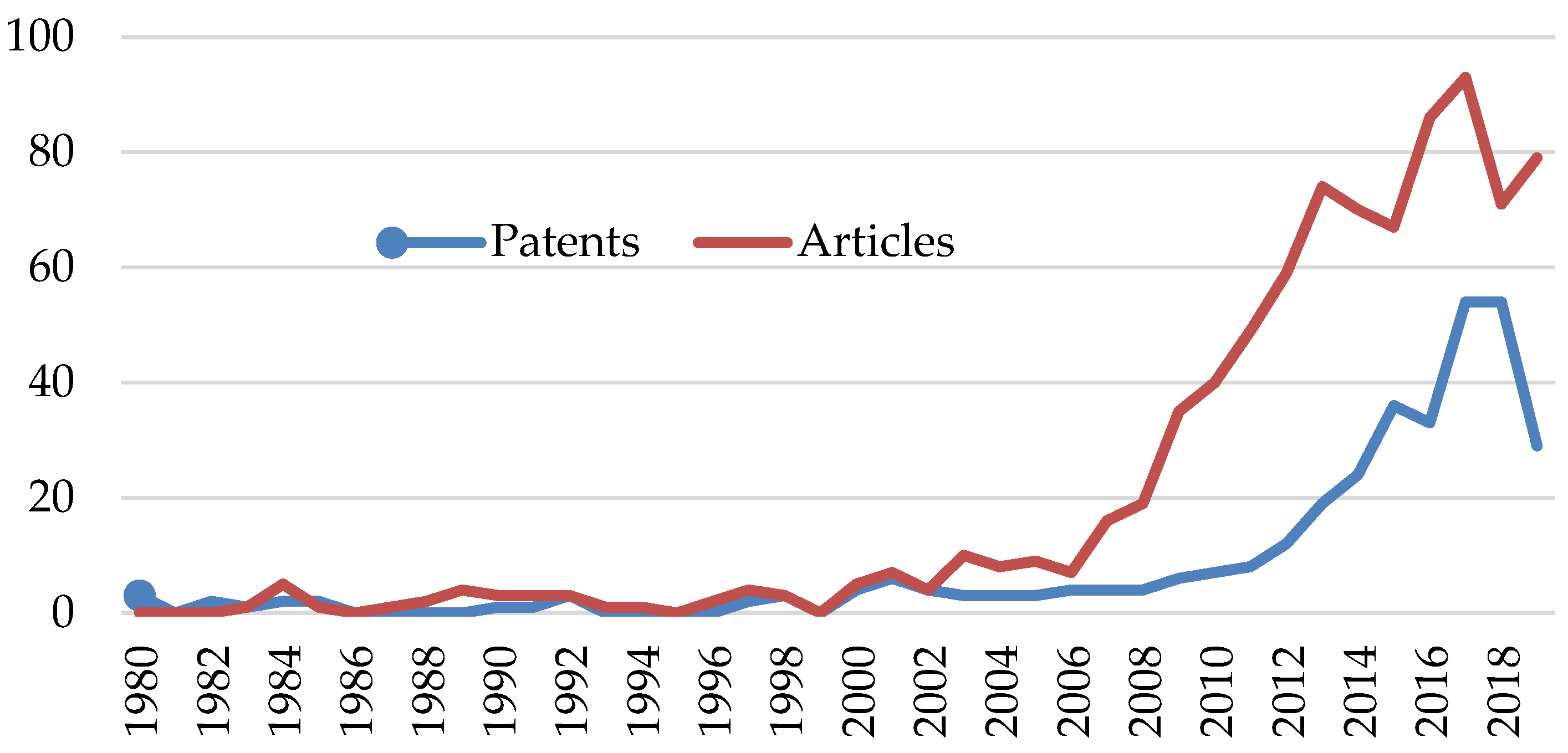

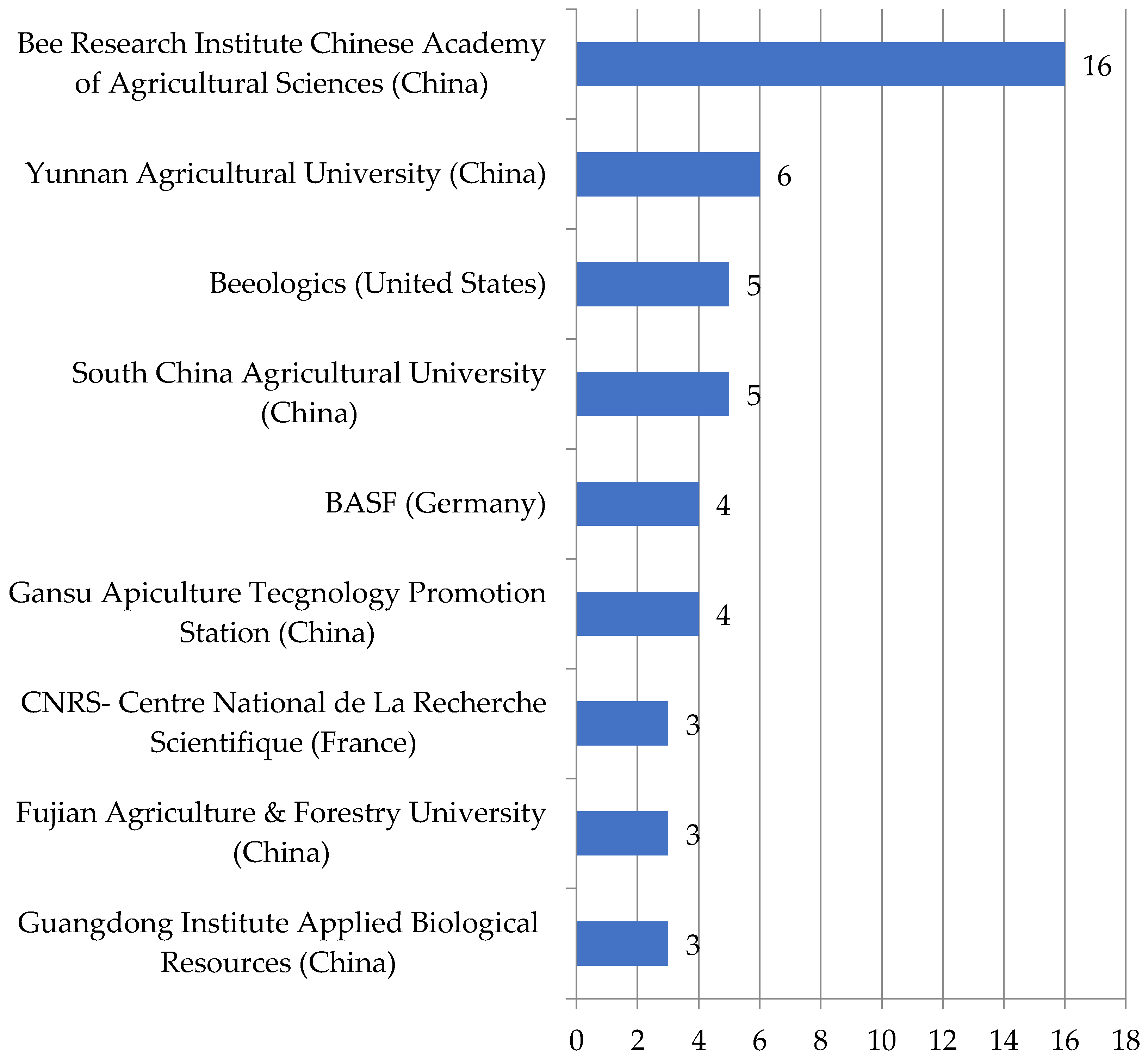
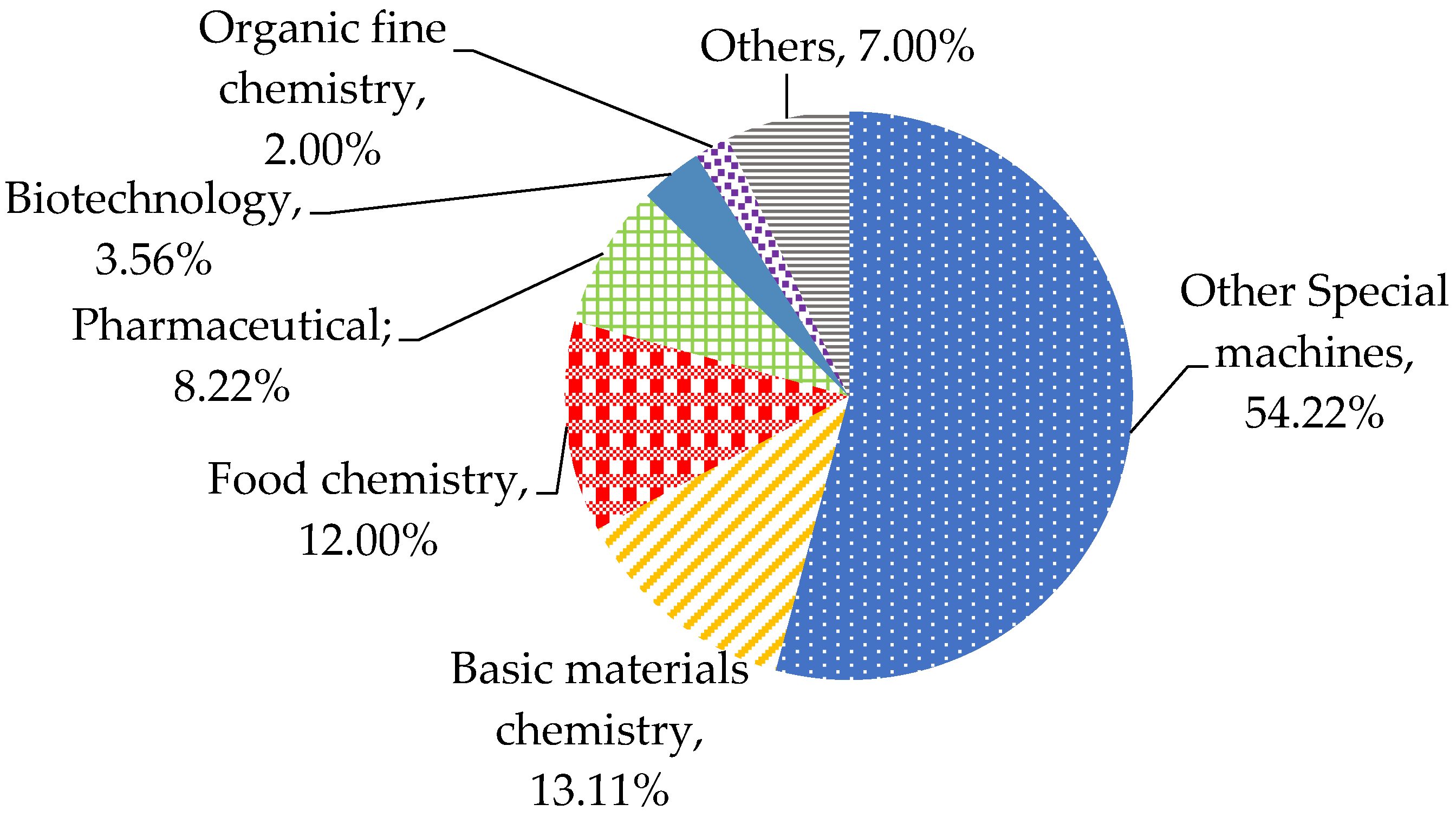
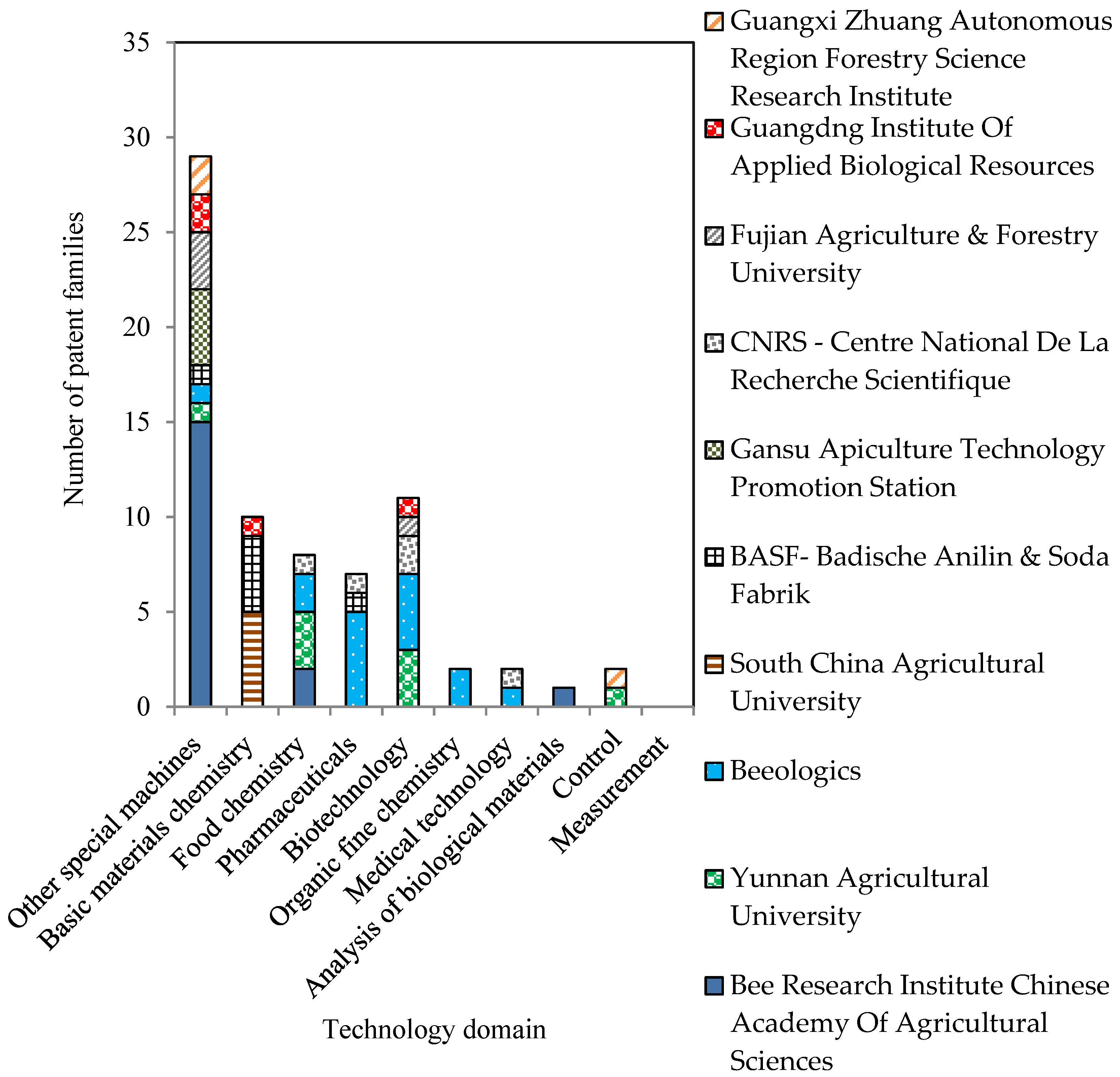
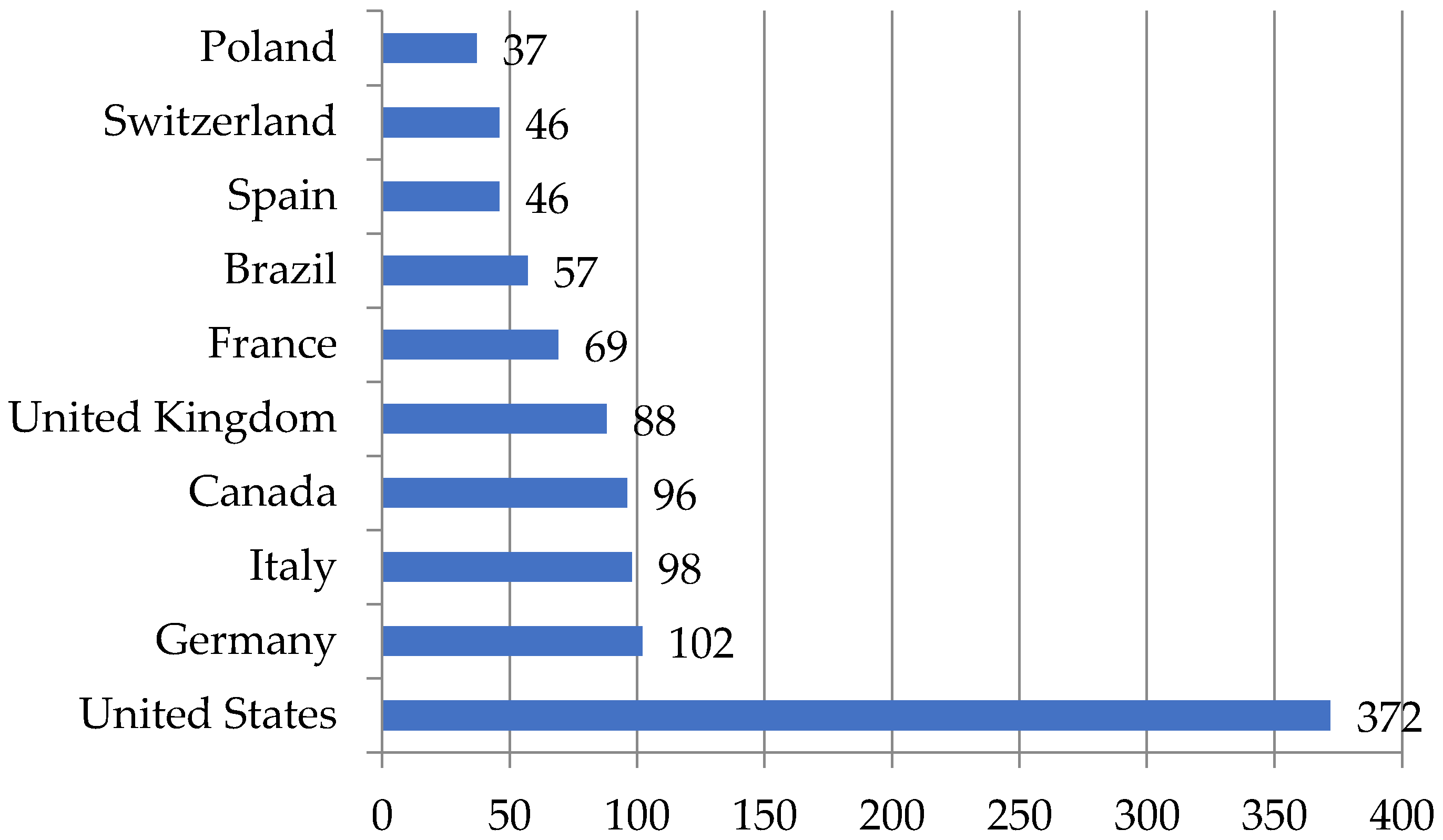
| IPC Code | Description | Quantity |
|---|---|---|
| A01K-047/06 | Other details of beehives, e.g., ventilating devices, entrances to hives, guards, partitions or bee escapes | 106 |
| A01K-047/00 | Beehives | 60 |
| A01K-067/033 | Rearing or breeding invertebrates; New breeds of invertebrates | 52 |
| A01K-051/00 | Appliances for treating beehives or parts thereof, e.g., for cleaning or disinfecting | 34 |
| A23K-050/90 | For insects, e.g., bees or silkworms | 34 |
| A01K-047/02 | Construction or arrangement of frames for honeycombs | 33 |
| A01K-053/00 | Feeding or drinking appliances for bees | 24 |
| A23K-020/163 | Sugars; Polysaccharides | 24 |
| A01K-049/00 | Rearing-boxes; Queen transporting or introducing cages | 21 |
| A23K-010/30 | From material of plant origin, e.g., roots, seeds or hay; from material of fungal origin, e.g., mushrooms | 20 |
| Coefficient | Value |
|---|---|
| r | 0.8869 |
| r2 | 0.7865 |
| ρ value (approx.) | 0.0001 |
Publisher’s Note: MDPI stays neutral with regard to jurisdictional claims in published maps and institutional affiliations. |
© 2021 by the authors. Licensee MDPI, Basel, Switzerland. This article is an open access article distributed under the terms and conditions of the Creative Commons Attribution (CC BY) license (https://creativecommons.org/licenses/by/4.0/).
Share and Cite
Ziegler, C.; Sinigaglia, T.; Martins, M.E.S.; Souza, A.M. Technological Advances to Reduce Apis mellifera Mortality: A Bibliometric Analysis. Sustainability 2021, 13, 8305. https://doi.org/10.3390/su13158305
Ziegler C, Sinigaglia T, Martins MES, Souza AM. Technological Advances to Reduce Apis mellifera Mortality: A Bibliometric Analysis. Sustainability. 2021; 13(15):8305. https://doi.org/10.3390/su13158305
Chicago/Turabian StyleZiegler, Cristiano, Tiago Sinigaglia, Mario Eduardo Santos Martins, and Adriano Mendonça Souza. 2021. "Technological Advances to Reduce Apis mellifera Mortality: A Bibliometric Analysis" Sustainability 13, no. 15: 8305. https://doi.org/10.3390/su13158305
APA StyleZiegler, C., Sinigaglia, T., Martins, M. E. S., & Souza, A. M. (2021). Technological Advances to Reduce Apis mellifera Mortality: A Bibliometric Analysis. Sustainability, 13(15), 8305. https://doi.org/10.3390/su13158305






